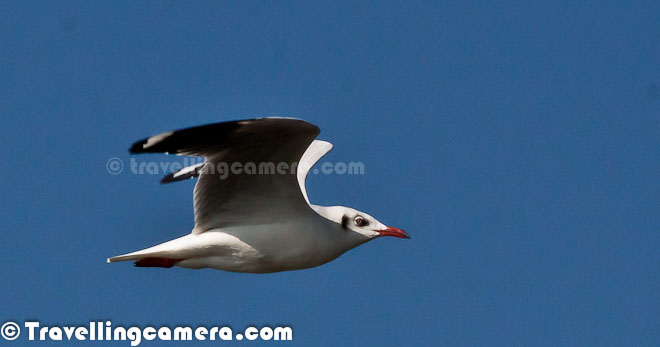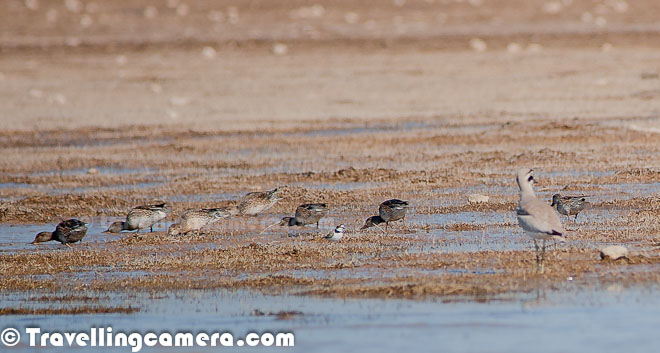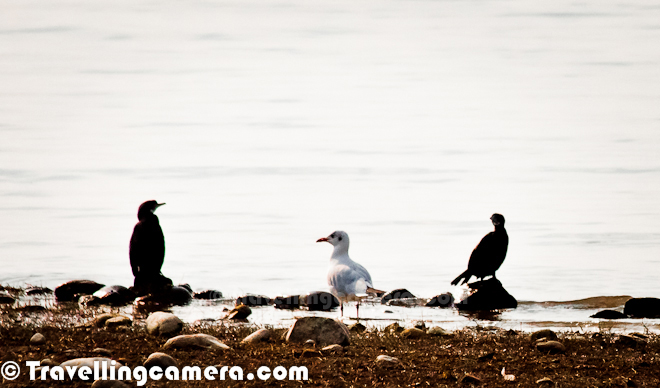Wild Wings of Pong Dam : A Series on Migratory Birds we saw at Pong Water reservoir during Winters of 2012 @ Himachal Pradesh India || PART-1
So far we have shared around 8 Photo Journeys form Pong Dam & Masroor and here comes a series on Birds we met during the two days of official Bird Counting by Wildlife Department, Himachal Pradesh. This whole series is divided into four parts, where we shall share photographs of different Birds our Travellingcamera could shoot...
The very First Photograph of this series shows 'Brown Headed Gull'. Gulls are birds which are most closely related to the terns and only distantly related to auks, skimmers, and more distantly to the waders. Photograph of this Gull was clicked when we were in a boat and going towards the other shore of Pong Dam Lake. I am not very sure if this is behavior of a Gull but most of the gulls were seen flying on top of water most of the time. Until the twenty-first century most gulls were placed in the genus Larus. Check out more about Gulls and different variants as per their features at - http://en.wikipedia.org/wiki/Gull
Bar Headed Goose were in largest number in Pong Water Reservoir of Himachal Pradesh. Here is separate Photo Journey on Bar Headed Goose, which can be checked - HERE
'Black Kite'
The Black Kite is a medium-sized bird. Unlike others of the Accipitridae group, they are opportunistic hunters and are more likely to scavenge. They spend a lot of time soaring and gliding in thermals in search of food. Their angled wing and distinctive forked tail make them easy to identify. There was group of 12 Black Kites around the Lake shore. Most of the birds arund were moving away from this flock of Black Kites. This kite is widely distributed through the temperate and tropical parts of Eurasia and parts of Australasia and Oceania, with the temperate region populations tending to be migratory. Several subspecies are recognized and formerly had their own English names. The European populations are small, but the South Asian population is very large. More details about Black Kite can be checked at http://en.wikipedia.org/wiki/Black_Kite
'Black Winged Stilt'
The Black-winged Stilt, Common Stilt OR Pied Stilt is a widely distributed very long-legged wader in the avocet and stilt family. There were around 8 such birds moving around the shoreline. During 45 minutes, I didn't see them flying and were continuously finding something to eat. Opinions about this bird differ as to whether the birds treated under the scientific name H. himantopus ought to be treated as a single species and if not, how many species to recognize. We saw these birds on wet areas around the shoreline of main lake. These birds were eating something from the wet soil with some grass on it. The portion of land seen above in Photograph was very near to the shoreline of Pong Dam Lake. Check out more about Black-Winged Stilt at http://en.wikipedia.org/wiki/Black-winged_Stilt
Common Sandpiper
The Common Sandpiper is a small Palearctic wader. Common Sandpiper and its American sister species, the Spotted Sandpipers make up the genus Actitis. They are parapatric and replace each other geographically... Stray birds of either species may settle down with breeders of the other and hybridize. Hybridization has also been reported between the Common Sandpiper and the Green Sandpiper, a basal species of the closely related shank genus Tringa. More information about Common Sandpiper and other relevant species can be checked at http://en.wikipedia.org/wiki/Common_Sandpiper
Common Teal with Little Cormants
Cormorants were again in huge number at Pong Dam Lake and there were different types of Cormorants around Shore line of the lake. Small Cormorants to the ones with orangish brown breast and few with white spots around forehead. There is a separate Photo Journey dedicated to Cormorants and can be checked - HERE
Cormorants are fish eaters and can be seen oding some clever actions around water bodies. These birds are most hated in pong Region of Nagrota Surian because local folks feel that cormorants reduce their income by eating lot of fish, which is technically denied by Conservation department.
Common Teals with Great Thicknee
The Great Stone-curlew or Great Thick-knee is a large wader which is a resident breeder in tropical southern Asia from India, Pakistan, Sri Lanka into South-east Asia. This species prefers gravel banks along rivers or large lakes, and also beaches. Great Thicknee tends to be wary and flies off into the distance ahead of the observer, employing powerful, rather stiff wingbeats.
The Great Thick-knee is a large wader at 50–56 cm, and has a massive 7 cm upturned bill. It has unstreaked grey-brown upper parts and breast, with rest of the underparts whitish. The face has a striking black and white pattern, and the bill is black with a yellow base. The eyes are bright yellow and the legs a duller greenish-yellow.
The Great Thick-knee is a large wader at 50–56 cm, and has a massive 7 cm upturned bill. It has unstreaked grey-brown upper parts and breast, with rest of the underparts whitish. The face has a striking black and white pattern, and the bill is black with a yellow base. The eyes are bright yellow and the legs a duller greenish-yellow.
While flying, the Great Thick-knee shows black and white flight feathers on the upperwing, and a mainly white underwing. Sexes are similar, but young birds are slightly paler than adults. The call is a wailing whistle, given mainly at night, as with other birds in this family. The Great Thick-knee eats crabs, large insects, and other animal prey. More details about Great Thicknee can be checked at - http://en.wikipedia.org/wiki/Great_Thick-knee
Cormorants with Black Headed Gull
The Black-headed Gull is a small gull which breeds in much of Europe and Asia and also in coastal eastern Canada. Most of the population is migratory, wintering further south, but some birds in the milder western most areas of Europe are resident. Some birds will also spend the winter in northeastern North America, where it was formerly known as the Common Black-headed Gull. As is the case with many gulls, it had previously been placed in the genus Larus. More information about Black Headed Gull can be checked at - http://en.wikipedia.org/wiki/Black-headed_Gull
Cormorants with a Gull and Grey Egret
An egret is any of several herons, most of which are white and several of which develop fine plumes during the breeding season. The distinction between a heron and an egret is rather vague and depends more on appearance than biology. The word 'egret' comes from the French word 'aigrette' that means both 'silver heron' and 'brush' referring to the long filamentous feathers that seem to cascade down an egret's back during the breeding season. More details can be found at - http://en.wikipedia.org/wiki/Egret
Female Common Teal
The Eurasian Teal or Common Teal is a common and widespread duck which breeds in temperate Eurasia and migrates south in winter. The Eurasian Teal is often called simply the Teal due to being the only one of these small dabbling ducks in much of its range. The bird gives its name to the blue-green color teal.
Common Teal is commonly found in sheltered wetlands and feeds on seeds and aquatic invertebrates.This Photograph was shot from the boat which is one of the main reason that bird has got direct lighting which was main challenge when we were walking around the shoreline of Pong Dam Lake.
More information about Common Teal can be found at - http://en.wikipedia.org/wiki/Common_Teal
Great Thinknee
Great Tit
Great Tit was not shot around the lake but was seen near Forest Guest house which is surrounded by huge trees. Various Great Tits were flying from one branch to other, while playing in a group. These birds were always making some sounds while flying from one tree to another.
The Great Tit is a bird in the tit family Paridae. It is a widespread and common species throughout Europe, the Middle East, Central and Northern Asia and parts of North Africa in any sort of woodland. It is generally resident and most Great Tits do not migrate except in extremely harsh winters. More details about Great tit can be seen at http://en.wikipedia.org/wiki/Great_Tit
Since I know least about birds, names were told by some experienced birders from Chandigarh and Delhi. After that details are pulled form Wikipedia !
More photographs of Pong's Birds will be shared soon...














.jpg)
Comments
Just check out the next lot with more photographs of Little Ringed plover @ http://phototravelings.blogspot.in/2012/02/wild-wings-of-pong-dam-series-on_17.html
81,000 have landed so far. The mark is expected to cross 150,000 this year.
And the species count has increased by 2, Ruddy Breasted Crake too landed yesterday! :)